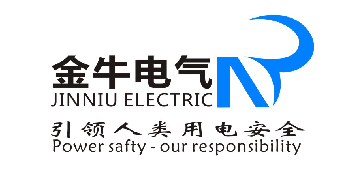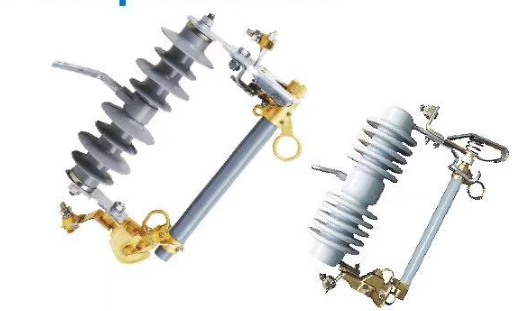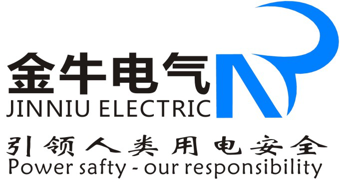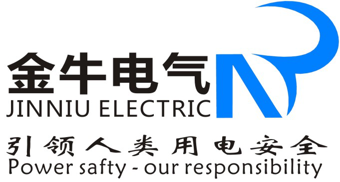
The drop fuse is mainly composed of the following components:
编号No. | 部件名称 Description |
1 | 螺母 Nut |
2 | 螺杆 Long Bolts |
3 | 安装支架Ⅰ Mounting BracketⅠ |
4 | 安装支架Ⅱ Mounting BracketⅡ |
5 | 瓷件 Porcelain Insulator |
6 | 弹簧垫圈 Spring Washer |
7 | 上盖槽 Onepiece channel |
8 | 熔管 Fuse Tube |
9 | 下支座 Lower Socket |
10 | 下触头 Lower contacts |
11 | 接线端 Connector |
12 | 上触头 Upper Contacts |
13 | 导向钩 Attachment Hooks |
14 | 操作环 Operation Ring |
The drop fuse is composed of insulating support, dynamic and static contacts and fuse tube. The static contact is installed at both ends of the insulating support, and the fuse tube is composed of an arc suppression tube in the inner layer and a phenolic paper tube or an oxygen reducing glass fiber cloth tube in the outer layer.

working principle
The pull load drop fuse increases the elastic auxiliary contact and arc extinguishing cover to switch the load current. During the normal operation of the drop fuse, the fuse tube forms a closed position after tensioning with the help of the fuse. When the system breaks down, the fault current makes the fuse fuse fuse quickly and form an arc. The arc suppression tube is heated by the arc and decomposes a large amount of gas, forming a high pressure in the tube and blowing strongly along the pipe. The arc is quickly stretched and extinguished. After the fuse is fused, the lower static contact loses tension and turns down, so that the tightening mechanism releases the fuse tube, and the fuse tube falls to form an obvious breaking position. When the load needs to be pulled, pull the moving contact with the insulating rod. At this time, the active and static contacts are still in contact. Continue to pull the contact with the insulating rod, and the auxiliary contact is also separated. An arc is generated between the outlets. The arc is elongated in the slit of the arc extinguishing cover, and at the same time, the arc extinguishing cover generates gas. When the electricity flows through zero, the arc is extinguished.
Functional use
The drop fuse is applicable to the power system with the frequency of 50Hz and the rated voltage of 35kV and below, and is installed on the high-voltage side of the distribution transformer or the main line of the distribution. The main functions are where the requirements for protection performance are not high. It can be used in conjunction with the disconnector to replace the automatic air switch; It can also be used with load switches to replace expensive circuit breakers. At the same time, it also has short-circuit protection, overload and isolation circuits.
Technical performance
The product performance meets the technical requirements of gb15166.3-94 national standard and iec282-2 international standard.
Service environmental conditions
1. Normal use conditions of the product:
a) Ambient air temperature: upper limit +40 ℃, lower limit -30 ℃;
b) The altitude shall not exceed 1000m;
c) The maximum wind speed shall not exceed 35m/s;
d) No frequent violent vibration.
2. The product is not applicable to the following places:
a) Places with combustion or explosion hazards;
b) Places with violent vibration or impact;
c) There are conductive, chemical gas effects, serious pollution (no more than pollution level: Level III), salt fog areas.
Melt selection
The size selection of fuse (piece) for high-voltage drop fuse is mainly based on different protection objects, and the corresponding model and fuse with corresponding time current characteristics are selected. At the same time, the coordination between upper and lower levels and other factors should be considered, so as to select specific parameters.
working process
The fuse is connected in series in the power line. During normal operation, the fuse with buttons is installed on the upper contact of the fuse tube and pressed by the pressure relief cap with the pressure piece. The fuse tail wire is pulled out through the fuse tube to twist the ejecting plate close to the nozzle and connect with the lower contact. Under the torsion of the ejecting plate, the fuse is always in a tight state and locks the movable joint. When the fuse is in the closing position, the contact of the whole fuse is more reliable due to the downward thrust of the upper static contact and the outward thrust of the spring piece.
When a fault occurs in the power system, the fault current will quickly fuse the fuse and generate an arc in the fuse tube. The fuse tube will produce a large amount of gas under the action of the arc. When the gas exceeds the given pressure value, the pressure relief sheet will open with the button button head, which reduces the pressure in the fuse tube and has a strong de dissociation effect when the current passes zero, so that the arc is extinguished. When the gas does not exceed the given pressure value, the pressure relief sheet does not act, and the strong de ionized gas generated when the current crosses zero is ejected from the lower nozzle, and the ejecting plate quickly pulls out the fuse tail line, so that the arc is extinguished. After the fuse is fused, the movable joint is released, and the fuse tube quickly falls under the pressure of the spring under the upper static contact, plus the effect of its own weight, cutting off the circuit and forming an obvious breaking gap.
Installation requirements
1. The fuse should be installed vertically to prevent the arc from falling on the adjacent live part.
2. The fuse and fixed contact shall be in straight line and contact without inclination.
3. For drop type fuses, the axis of the fuse tube should be 15~30 ° with the plumb line, and its rotating part should be flexible. When falling, it should not touch other objects.
4. The specification of fuse shall meet the design requirements, without bending, flattening or damage, and the fuse and contact shall be pressed tightly and firmly.
5. The rated current of the fuse and the fuse (wire or piece) must be marked on the fuse, and the capacity of the fuse should meet the requirements of the protected appliance. The fuse without calibration or without the rated current mark is not allowed to be used.
Operation and use
The high-voltage drop out fuse adopts insulated pole single-phase operation, and it is not allowed to operate with load. Through practice, it is found that when the first phase is opened by mistake with load, most cases are similar to disconnecting the parallel circuit or loop, and the disconnection voltage is low, so there will be no strong arc. When the second phase is opened with load, because the fracture voltage is line voltage, its fracture voltage is high, so strong arc will occur, which may lead to arc short circuit of adjacent phases, which will threaten the safety of personnel and equipment. When the third phase is opened, the circuit tends to be open circuit (no current or very small current), so no arc will be generated [3]. Therefore, reasonable and correct operation is crucial. The methods summarized according to experience are:
1. Preparation: make preparations before operation, select insulating rods with corresponding voltage levels and qualified, wear insulating gloves and shoes to ensure safety.
2. Check: carefully check the equipment name and number before operation to determine the correctness of the operation object.
3. Standing position: choose a position convenient for operation. Generally, it is appropriate to stand in front of and below the drop fuse of the current operating phase. If it is the operation on the tower, you should also fasten the safety belt.
4. Alignment: during operation, align the moving contact of the drop fuse with its static contact to ensure the accuracy of closing.
5. Closing: when closing the high-voltage drop fuse, it must be rapid, decisive and accurate, but when closing to the end, it must not be too hard to prevent damage to the support insulator and other equipment.
In addition, the current characteristics of high-voltage drop out fuses are unstable in daily operation, resulting in coordination errors and skip tripping with the change of operating environment and temperature; The quality of the fusion tube is poor, and the deformation and delamination occur, resulting in accidental drop; Long term use is prone to poor contact between the upper and lower contacts, which is easy to cause contact heating, burning loss and contact oxidation; Its performance is damaged due to improper operation, use and installation during operation and maintenance. Monitoring in this area should be improved.
Operation and maintenance management
1. In order to make the fuse operate more reliably and safely, in addition to strictly selecting qualified products and accessories (including fuses) produced by regular manufacturers according to the requirements of the regulations, the following matters should be paid special attention to in the operation and maintenance management:
① Whether the rated current of the fuse matches the melt and load current values properly. If not, it must be adjusted.
② Each operation of the fuse must be careful and careful, not careless, especially the closing operation, and the dynamic and static contacts must be in good contact.
③ The standard melt must be used in the melting tube. It is forbidden to replace the melt with copper wire and aluminum wire, and it is not allowed to bind the contact with copper wire, aluminum wire and iron wire.
④ For newly installed or replaced fuses, the acceptance process must be strict, and the quality requirements must be met. The installation angle of the fuse tube must reach a downward angle of about 25 °.
⑤ After the melt is fused, it should be replaced with a new melt of the same specification. It is not allowed to connect the fused melt and then put it into the fuse tube for further use.
⑥ The fuse should be inspected regularly, at least once a month at night, to check whether there are discharge sparks and poor contact. If there is discharge, there will be a hissing sound, which should be handled as soon as possible.
2. During spring inspection and outage maintenance, the fuse shall be inspected as follows:
① Whether the static and moving contacts are consistent, tight and intact, and whether there are burn marks.
② Whether the rotating part of the fuse is flexible, whether there are abnormalities such as rust and inflexible rotation, whether the parts are damaged, and whether the spring is rusted.
③ Whether the melt itself has been damaged, and whether it has been heated and stretched too much after long-term power on to become loose and weak.
④ Whether the arc suppression pipe for gas production in the melting pipe is burned after multiple actions, whether it is damaged and deformed after exposure to the sun and rain, and whether the length is shortened.
⑤ Clean the insulator and check whether there is damage, crack or discharge trace. After disassembling the upper and lower leads, use a 2500V megger to test the insulation resistance, which should be greater than 300m Ω.
⑥ Check whether the upper and lower connecting leads of the fuse are loose, discharged or overheated






